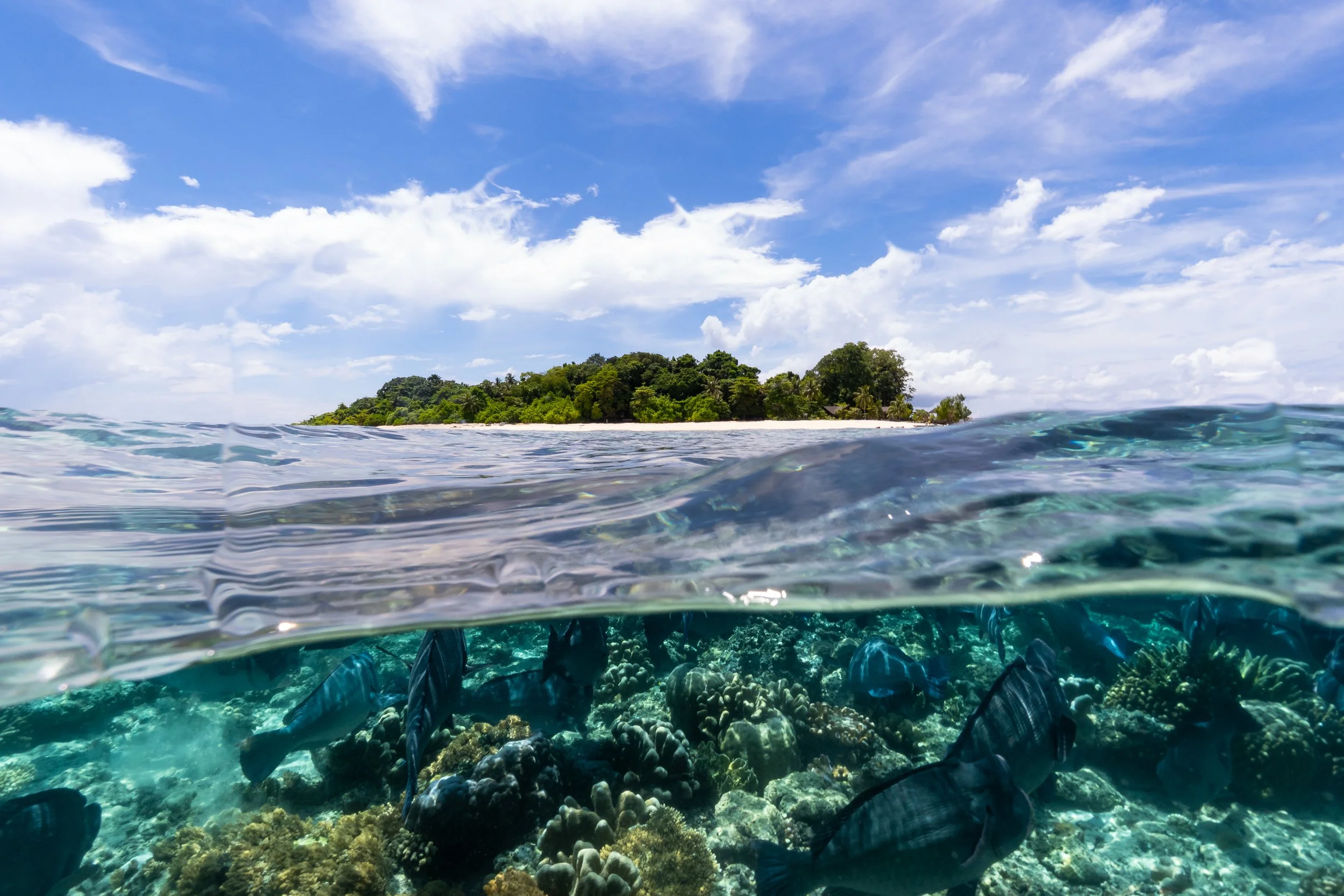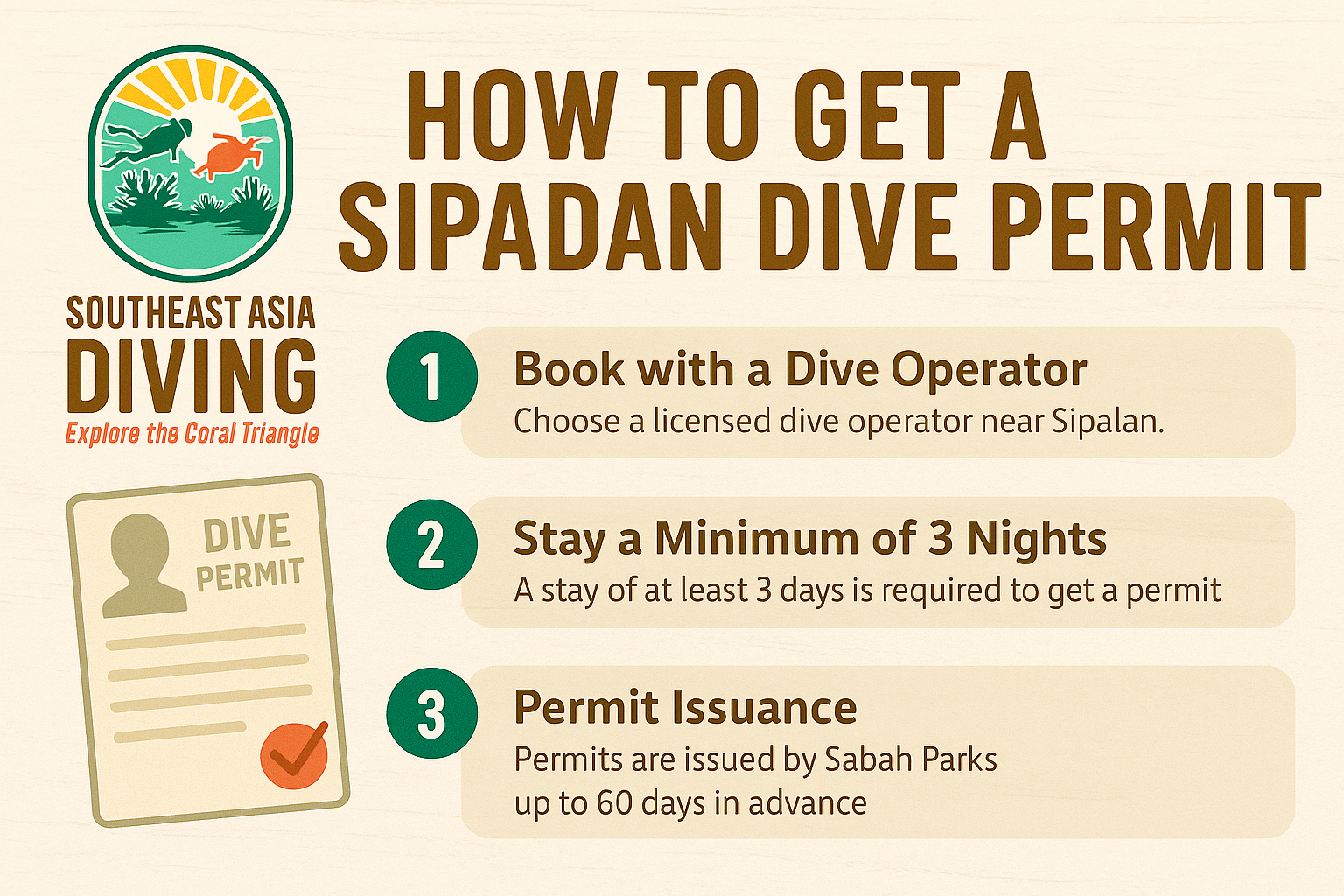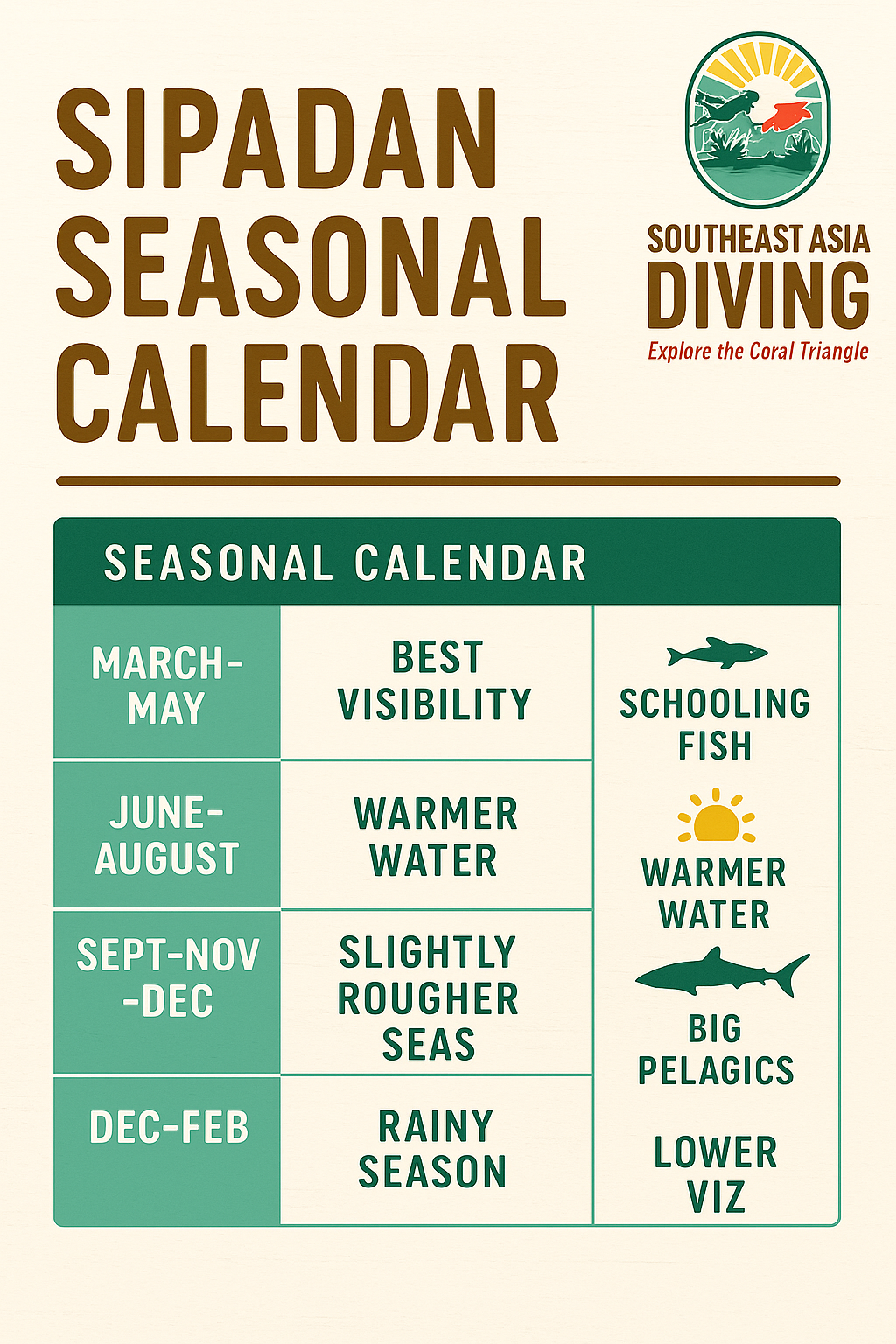Sipadan Diving Guide: Permits, Best Season, and What to Expect
Sipadan Island, Malaysia
Introduction
Sipadan Island is a name that echoes through dive circles with a kind of reverence. Ask any seasoned diver about their top bucket-list destinations, and Sipadan will almost certainly make the list — often in the top three. This tiny speck of land in the Celebes Sea, off the east coast of Sabah, Malaysian Borneo, packs a punch far beyond its size. It is Malaysia’s only oceanic island, formed atop an extinct volcano that rises 600 metres from the seabed, and it sits squarely within the nutrient-rich Coral Triangle.
From vertical drop-offs teeming with life to the famous “barracuda tornado,” Sipadan offers a rare mix of pelagic action, pristine coral gardens, and staggering biodiversity. But it’s not as simple as just turning up and booking a dive. Strict conservation rules, limited permits, and seasonal conditions mean you need to plan carefully to get the best out of your visit.
In this comprehensive guide, you’ll find:
How to get a Sipadan diving permit
The best times of year to visit
A dive site-by-dive site breakdown
Marine life highlights
Travel logistics and accommodation tips
Gear recommendations
Photography advice
Where is Sipadan and Why is it So Famous?
Sipadan lies about 35km off the coast of Semporna in Sabah, Malaysia. What sets it apart is its location at the meeting point of deep ocean currents, which funnel nutrients up the steep volcanic slopes, feeding an extraordinary variety of marine life.
Why divers love Sipadan:
Turtles by the dozen — both green and hawksbill
Shark encounters — grey reef, whitetip, and occasional hammerhead
Schooling fish — barracuda, trevally, and bumphead parrotfish
Macro life — nudibranchs, frogfish, pygmy seahorses (especially in nearby Mabul/Kapalai)
Pristine walls — covered in soft corals, gorgonians, and sponges
A Brief History and Conservation Efforts
Sipadan was declared a protected area in 2004, and in 2005 all resorts and accommodation were removed from the island to minimise human impact. Today, no one is allowed to stay overnight — all dives are day trips from neighbouring islands like Mabul, Kapalai, or from Semporna on the mainland.
The strict permit system (just 176 divers per day) ensures that the reefs remain healthy and marine life is not over-pressured. Sabah Parks manages the permits, and only licensed dive operators are allocated slots.
This careful management is why, despite being a household name in diving for decades, Sipadan’s reefs are still thriving.
Sipadan Dive Sites Map
Sipadan Dive Site Map
From the moment you see Sipadan’s dive site map, you realise how close-knit and yet varied its underwater landscapes are. Most sites are a short boat ride apart, but each offers a different character and range of encounters.
Sipadan Dive Permit — How it Works
Key Facts:
Only 176 permits issued per day
Permits are allocated to licensed operators
Most resorts rotate guests so everyone gets at least one Sipadan day
Since 2023 Sabah parks only allows for 2 dives per diver, per day.
Steps to Secure a Permit:
Book with a Licensed Operator — Independent diving is not allowed.
Stay Multiple Nights — 3–5 night packages greatly increase your chances.
Book Early — 6–12 months in advance for peak months.
Be Flexible — Weather or currents can affect your Sipadan day.
💡 Pro Tip: Even if you only get one Sipadan day, nearby Mabul and Kapalai are world-class for macro photography and critter hunting.
Best Time to Dive Sipadan
Sipadan is diveable year-round, but conditions vary:
Season
Conditions & Highlights
March–May
Best viz (20–40m), huge schools, calm seas.
June–Aug
Warm water, more tourists, ideal for casual divers.
Sept–Nov
Bigger pelagics, slightly rougher seas, fewer crowds.
Dec–Feb
Rainy season, lower viz, quieter.
🌊 Recommendation: March–May for crystal water and peak life.
Diving Conditions and Currents
Water Temperature: 27–30°C year-round
Currents: Can be strong at sites like Barracuda Point — reef hooks useful
Visibility: Up to 40–50m in the best months
Depth: Sites range from shallow coral gardens to deep blue walls
Dive Sites in Detail
Barracuda Point
The most famous — and for good reason, Barracuda Point is widely regarded as one of the top dive sites in the world. The reef begins in the shallows at around 5 meters and drops steeply to over 40 meters, making it suitable for multi-level profiles. Most of the marine action occurs between 10–25 meters, where divers can comfortably explore the reef wall and sandy channels.
The main attraction is the enormous school of chevron barracuda that often forms a dense tornado, sometimes encircling divers in a spiraling wall of fish. In addition to barracuda, the site is home to large schools of jackfish, bumphead parrotfish, and frequent sightings of reef sharks such as white-tips and grey reef sharks. Turtles are abundant, with both green and hawksbill species regularly encountered. Eagle rays, groupers, and occasional hammerheads may also be spotted further out in the blue.
Currents are typically medium to strong and can change direction quickly, so most dives here are done as drifts. This allows divers to cover more ground along the wall while being carried by the current. Because of these conditions, Barracuda Point is recommended for divers with some experience in handling current.
Visibility is generally good year-round, averaging 15–30 meters, though it can vary with tides and weather. The best time of day to dive is in the morning when fish activity is highest, currents are more predictable, and chances of seeing the famous barracuda tornado are greatest. Afternoon dives can still be rewarding but are more variable in terms of current and fish schooling behavior.
South Point
South Point is one of the deeper and more challenging sites around the island, popular with experienced divers seeking encounters with large pelagic species. The reef starts on a shallow plateau at around 5–8 meters before dropping sharply down a vertical wall to well beyond 50 meters. Most dives are conducted between 15–30 meters, where the reef wall is covered in hard corals, sponges, and sea fans.
The site is best known as one of Sipadan’s few places where hammerhead sharks are occasionally sighted, particularly in deeper waters around 30–40 meters. Other large pelagics such as grey reef sharks, white-tip reef sharks, eagle rays, and schools of trevally are commonly seen. Turtles are frequent visitors along the wall, and macro divers can also find nudibranchs, shrimp, and small reef critters on the coral shelf.
Currents at South Point can be strong and variable, often running along the wall, which makes this site more suitable for advanced divers with good drift diving experience. It is also one of the deepest points around Sipadan, so careful attention to depth and air consumption is important.
Visibility generally ranges from 15–30 meters, though conditions can shift quickly depending on tides. The best time to dive South Point is early in the morning, when the likelihood of encountering schooling hammerheads and other pelagics is highest. Midday dives can still offer excellent reef and shark encounters, but the bigger schools tend to appear in the early hours.
Turtle Cavern
Turtle Cavern, is one of the island’s most unusual and atmospheric dive sites, known for its system of limestone caves and tunnels hidden within the reef wall. The entrance lies around 18–20 meters, leading into a series of wide chambers connected by narrow passageways that extend back into the reef. The cavern itself is spacious, with ceilings adorned by stalactite-like formations and sandy bottoms scattered with turtle skeletons — a reminder of turtles that became lost inside.
Marine life around the cavern includes large green and hawksbill turtles, which often rest near the entrance, along with reef fish, parrotfish, and occasional reef sharks cruising the outside wall. Inside the cavern, marine life is sparse, but divers may spot sponges, crabs, and small nocturnal creatures clinging to the walls. The site is more about the unique topography and history than fish density.
Because of its overhead environment, Turtle Cavern is considered a specialty dive. Penetration into the cave system is only recommended for divers with proper training in cavern or cave diving, as disorientation and silt-outs are real risks. Most recreational divers limit their visit to the entrance area and the outer reef wall, which also offers rich coral growth and good fish life.
Visibility outside the cavern is usually 15–25 meters, while inside it depends on diver control and lighting. Currents are generally mild around the cavern entrance compared to other sites on Sipadan. The best time to dive is during the morning, when light penetration enhances the cavern’s atmosphere and turtles are more active.
The Drop Off
The Drop Off is, located just a few fin kicks from the shore near the old jetty. Here, the reef dramatically plunges from only a couple of meters below the surface down to more than 600 meters into the abyss, creating one of the world’s steepest and most impressive vertical walls. Divers can start in the shallows among hard corals and reef fish before drifting along the sheer drop, which is covered in sponges, sea fans, and vibrant coral life between 5–30 meters.
The wall attracts a huge variety of marine life. Turtles are especially abundant, with green and hawksbill species resting in ledges and cruising past throughout the dive. Large schools of jackfish and bumphead parrotfish are commonly seen, while white-tip reef sharks patrol the wall. Lucky divers may encounter grey reef sharks, eagle rays, and barracuda in the blue. Macro enthusiasts can also find nudibranchs, shrimps, and other small critters tucked into the wall’s crevices.
Currents at The Drop Off vary from mild to strong, with some sections sheltered and others carrying divers along the wall in effortless drifts. This makes the site accessible to a range of experience levels, though beginners should stay in the shallows near the reef crest, while advanced divers can explore deeper sections.
Visibility usually ranges from 15–30 meters, with conditions stable throughout much of the year. The best time to dive The Drop Off is in the morning, when fish schools are more active and natural light highlights the dramatic contours of the wall. Afternoon dives are also popular here, especially as it is one of the closest and most accessible sites from the island’s entry point.
Mid Reef
Mid Reef lies between Barracuda Point and South Point and offers a more relaxed but equally rewarding dive. The reef slopes gently from around 5 meters before dropping into a vertical wall that extends well beyond 40 meters. Along the slope, divers can explore coral gardens teeming with hard and soft corals, sponges, and sea fans, while the wall provides ledges and overhangs that shelter reef life.
Marine life here is diverse, with frequent sightings of green and hawksbill turtles, schooling snapper, fusiliers, and trevally. White-tip reef sharks and grey reef sharks are often seen cruising the wall, and barracuda sometimes pass by in smaller groups compared to the massive tornado at Barracuda Point. Bumphead parrotfish, groupers, and the occasional eagle ray also make appearances, while macro life such as nudibranchs and shrimp can be spotted among the corals.
Currents at Mid Reef are generally less intense than at Barracuda Point or South Point, making it suitable for divers of varying experience levels. Depending on the day, it can be either a gentle drift dive or a calm exploration along the reef.
Visibility typically ranges from 15–30 meters, with stable conditions year-round. The best time to dive Mid Reef is in the morning, when schools of fish are most active and the chance of spotting larger pelagics is highest. However, the site remains a reliable option throughout the day, particularly when currents at more exposed points are too strong..
Coral Gardens
Coral Gardens is one of the most colorful and accessible sites on the island, ideal for appreciating Sipadan’s healthy reef ecosystem. The site begins in shallow water at around 5 meters and slopes gently down to a wall that drops past 40 meters, offering options for both novice and experienced divers. The shallows are carpeted with hard corals, table corals, and patches of soft coral, creating a vibrant reef top that is especially beautiful in good light.
Marine life here is abundant and varied. Large schools of reef fish such as anthias, damselfish, and fusiliers hover above the corals, while green and hawksbill turtles rest or graze in the shallows. White-tip reef sharks are commonly seen along the wall, and divers may also encounter barracuda, trevally, and bumphead parrotfish. For macro enthusiasts, the coral gardens shelter nudibranchs, pipefish, and shrimp, making it a site that caters to both wide-angle and macro photography.
Currents are usually mild compared to more exposed sites like Barracuda Point or South Point, making Coral Gardens an excellent choice for beginner divers or those seeking a more relaxed dive. Gentle drift dives are common, but the site can also be explored at an easy pace without being carried too far by the current.
Visibility typically ranges from 15–30 meters, with consistent conditions most of the year. The best time to dive Coral Gardens is in the morning, when the reef is most active and natural light enhances the corals’ colors. However, it is also a popular site for afternoon dives, thanks to its easy conditions and proximity to the island.
Marine Life Highlights
Sipadan’s location means you can see both oceanic wanderers and reef residents in one dive:
Turtles — both green and hawksbill
Sharks — grey reef, whitetip, occasional leopard or hammerhead
Schooling fish — jacks, barracuda, bumphead parrotfish
Macro — nudibranchs, pygmy seahorses, frogfish
Gear Recommendations
3mm wetsuit – for comfort in 27–30°C water
Wide-angle lens – for schooling fish and walls
Macro lens – if you’re doing Mabul/Kapalai too
Spare mask strap & o-rings – limited gear shops nearby
Photography Tips
Early morning dives at South Point can give magical light rays.
Midday dives at Barracuda Point for the tornado.
Use a fast shutter to freeze fish movement in schools.
Travel Logistics
Fly to: Tawau Airport (TWU)
Transfer: Tawau → Semporna by road (1.5hrs) → boat to Mabul/Kapalai
Stay: Mabul (closest), Kapalai (luxury), Semporna (budget)
Costs & Packages
Expect USD $200–$350/day for packages including:
Accommodation
Meals
2 dives/day (As of 2023)
Boat transfers
Permit fees
Nearby Dive Destinations
Mabul Island – macro heaven, frogfish, flamboyant cuttlefish
Kapalai – stunning house reef and overwater bungalows
Tun Sakaran Marine Park – less visited, excellent coral
Tips for an Incredible Sipadan Trip
Book early
Bring your own dive computer
Respect marine life — no touching
Combine Sipadan with Mabul/Kapalai for variety
Conclusion
Sipadan is not just a dive site — it’s a rite of passage for divers from around the world. Each dive offers something different, from walls that drop into the blue abyss to caverns filled with history, and reefs alive with both delicate macro life and powerful pelagic hunters. With careful planning and respect for its strict conservation limits, you can explore an underwater ecosystem that remains as close to pristine as anywhere on earth.
The experience is about more than ticking off marine species — it’s about drifting through swirling barracuda, hovering eye-to-eye with turtles, and feeling the pull of strong currents that deliver so much life to these waters. Every dive at Sipadan carries the sense that you are witnessing the ocean as it should be: raw, balanced, and breathtakingly alive.
When you surface and look back on the island, you’ll understand why Sipadan holds legendary status. It is not simply another destination, but a place that etches itself into memory — a reminder of the ocean’s power, beauty, and fragility. For many, a journey to Sipadan marks a milestone in their diving life, one that will never be forgotten.



